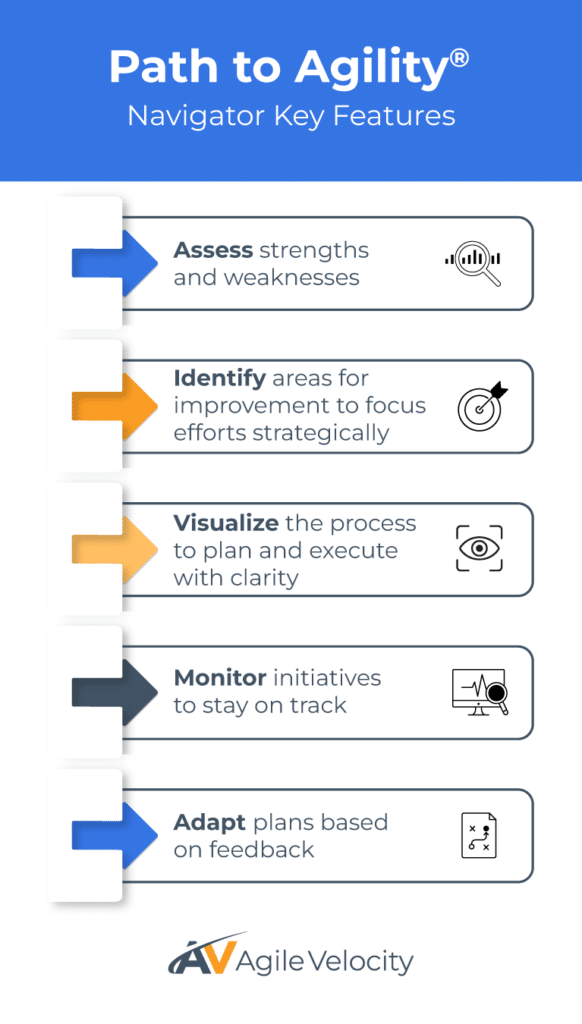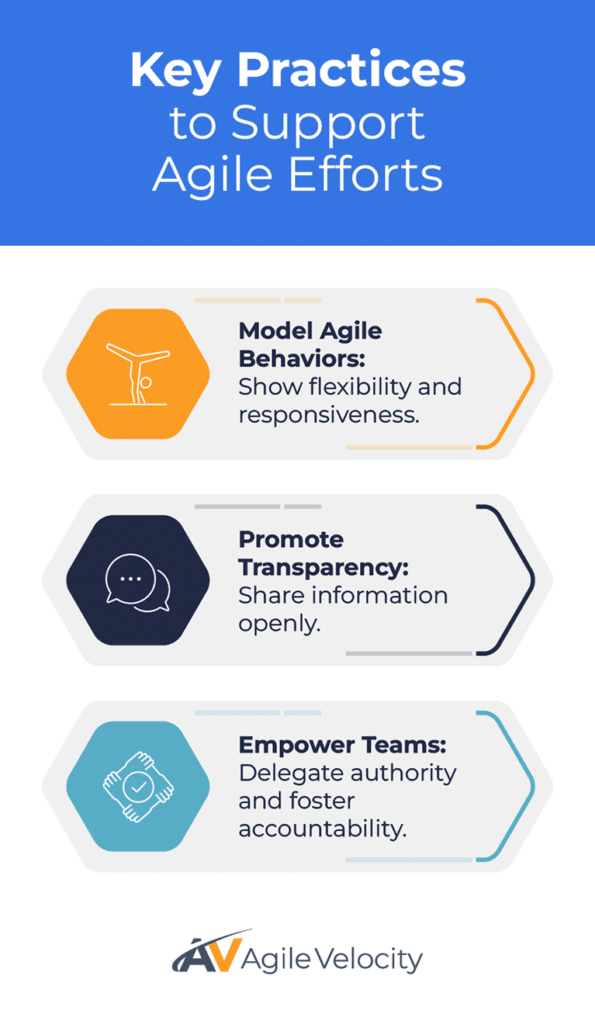An Agile-Friendly C-Suite embodies flexibility, collaboration, and a commitment to continuous improvement. It’s about embracing change and leading by example. Creating this environment starts at the top. As a C-level executive, your role in fostering organizational agility is pivotal. Your leadership sets the tone for the entire organization, influencing how teams adapt to new methodologies and respond to market dynamics.
Agile Transformation isn’t just a buzzword; it’s a necessary shift to stay competitive and deliver value faster.
Agile Transformation involves fundamentally changing the organizational mindset and culture. This guide will equip you with strategies to champion Agile practices within your leadership team and align them with your business goals.
The Agile Mindset—Why It’s Critical for Executives
Adopting an Agile Mindset is more than implementing new processes; it’s about reshaping how you think about leadership, collaboration, and customer value. Executives need to champion transparency and foster an environment where experimentation and learning from failure are encouraged. By placing a strong emphasis on adaptability and responsiveness, C-suite leaders can drive their organizations towards innovation and maintain a competitive edge in ever-evolving markets.
Components of an Agile Mindset
An Agile Mindset embraces flexibility, encourages innovation, and values customer feedback. It involves:
- Emphasizing Individuals and Interactions: Prioritizing people over processes ensures that team members feel valued and motivated to contribute their best work.
- Focusing on Working Solutions: Seeking practical outcomes over exhaustive documentation promotes efficiency and effectiveness in delivering value.
- Collaborating with Customers: Engaging customers as partners allows for better alignment of products and services with their evolving needs.
- Responding to Change: Adapting quickly to shifting market demands ensures that the organization remains relevant and competitive.
Cultivating an Agile Mindset Among Leadership Teams
Encourage your leadership team to:
- Participate in Agile Training: Invest in learning Agile practices and ways of working to ensure that leaders are well-versed in the principles and can effectively guide their teams.
- Lead by Example: Demonstrate Agile values in decision-making and interactions, setting a standard for the rest of the organization.
- Foster Open Communication: Promote transparency and inclusivity in discussions, ensuring that all voices are heard and valued.
- Embrace Continuous Learning: Encourage experimentation and learning from failures, creating an environment where innovation thrives.
When executives embody these principles, it filters down through the organization. Teams feel empowered to make decisions, innovate, and collaborate more effectively. This results in faster time-to-market, improved product quality, and higher Customer Satisfaction Scores.
Aligning Agile Transformation with Strategic Business Goals
Aligning Agile practices with your business objectives ensures that the transformation contributes directly to organizational success. Agile Transformation affects various aspects of your business, including:
- Market Responsiveness: The ability to adapt to market changes swiftly allows your organization to seize new opportunities and mitigate risks effectively.
- Customer Satisfaction: Delivering products that meet evolving customer needs enhances loyalty and drives repeat business.
- Operational Efficiency: Streamlining processes to eliminate waste leads to cost savings and better resource utilization.
- Innovation Capability: An Agile approach fosters a culture of continuous improvement and creativity, enabling your organization to develop cutting-edge solutions.
Integrating Agile Practices into Business Models
To integrate Agile into your existing models:
- Identify Strategic Goals: Clearly define what you aim to achieve, such as increasing market share, enhancing product quality, or improving customer engagement.
- Map Agile Practices to Goals: Align Agile with specific objectives to ensure that each practice supports your overarching business strategy.
- Engage Stakeholders: Involve all relevant parties in the transformation process to gain their buy-in and ensure that Agile practices are tailored to meet organizational needs and expectations.
Evaluating Success with Business Outcome Metrics
Use measurable outcomes to track progress:
- Key Performance Indicators (KPIs): Define KPIs that reflect the impact of agility on your goals, such as reduced time-to-market, increased customer satisfaction scores, or higher employee engagement levels.
- Regular Reviews: Schedule periodic assessments to evaluate performance against these KPIs, allowing you to identify areas of success and those needing improvement.
- Adjust Strategies: Be prepared to adapt based on insights gained, ensuring that your Agile Transformation remains aligned with evolving business objectives and market conditions.
The Importance of Intuitive Reporting Tools
Effective reporting tools help you:
- Communicate Progress: Keep stakeholders informed and engaged by providing clear and concise updates on transformation efforts.
- Visualize the Transformation Journey: Understand how different elements contribute to broader goals through visual dashboards and progress trackers.
- Make Data-Driven Decisions: Use real-time data to guide actions, ensuring that decisions are based on accurate and current information.
Utilizing Path to Agility® Navigator for Effective Assessment and Transformation Roadmaps


By assessing current capabilities and generating actionable insights, organizations can deliver more value faster. To assist in this journey, consider utilizing Path to Agility Navigator. This is a comprehensive tool designed to enhance organizational agility through continuous improvement.
Path to Agility Navigator offers assessments that evaluate up to 100 capabilities across various teams and departments, providing a detailed understanding of your organization’s Agile maturity. This foundational knowledge allows you to create targeted action plans that align with your strategic objectives towards achieving business outcomes, ensuring that your Agile Transformation efforts are both effective and sustainable.
In order to successfully navigate a transformation, it is important to visualize the process, track progress, and adjust course as needed. By visualizing the journey, individuals can map out a clear path from the current state to desired outcomes, enabling better planning and execution.
Tracking progress allows for monitoring how initiatives are advancing, ensuring that the transformation stays on course. While it is important to stay on course, you should also, stay Agile and adjust course as needed based on ongoing feedback. Doing so ensures the transformation remains responsive to new challenges and opportunities, ultimately leading to a successful outcome.
Request a Demo
Converting Assessment Results into Strategic Action Plans
By utilizing Path to Agility Navigator you can transform the insights into action by:
- Prioritizing Initiatives: Focus on changes that align with strategic goals, ensuring that resources are allocated to initiatives that will drive meaningful progress.
- Allocating Resources Effectively: Ensure teams have what they need to succeed, whether it’s training, tools, or additional personnel.
- Setting Realistic Timelines: Plan implementations that are achievable and measurable, preventing burnout and fostering steady progress.
Harnessing the full potential of Path to Agility Navigator can significantly enhance your Agile Transformation journey.
Fostering a Culture of Continuous Improvement Through Agile Leadership
Continuous improvement is the backbone of Agile practices. As a leader, cultivating this culture is essential to drive sustained innovation and operational excellence within the organization. Encouraging a culture of continuous improvement begins with setting a clear vision that aligns with the organization’s strategic objectives while being open to change and experimentation.
Leaders should actively promote a mindset where learning from mistakes is seen as a stepping stone to success rather than a setback. They can achieve this by creating an environment that supports risk-taking and values transparency, allowing team members to openly share ideas and collaborate on finding solutions to complex challenges.
Continuous Improvement involves:
- Ongoing Evaluation: Regularly assessing processes and outcomes to identify areas for enhancement.
- Incremental Changes: Making small adjustments that lead to significant gains over time, ensuring sustainable progress.
- Employee Involvement: Encouraging team members to contribute ideas, fostering a sense of ownership and accountability.
Leadership Techniques for Encouraging Innovation
Promote innovation by:
- Empowering Teams: Give teams autonomy to experiment and make decisions, which fosters creativity and accountability.
- Providing Resources: Allocate time and tools for exploration, enabling teams to test new ideas without excessive constraints.
- Recognizing Achievements: Celebrate successes and learn from failures, creating an environment where innovation is valued and supported.
Utilizing Feedback Loops and Data
Implement mechanisms like:
- Regular Retrospectives: Reflect on what worked and what didn’t, allowing teams to continuously refine their practices.
- Performance Metrics: Track key indicators such as lead time, cycle time, and defect rates to measure improvement.
- Customer Feedback: Incorporate input from customers to refine products and services, ensuring that your offerings meet their needs and expectations.
Setting Clear Objectives and Assessing Performance
Ensure clarity by:
- Defining Goals: Set specific, measurable objectives that guide teams towards desired outcomes.
- Aligning Expectations: Make sure everyone understands their role in achieving goals, fostering collaboration and accountability.
- Reviewing Regularly: Hold consistent check-ins to assess progress, address challenges, and adjust strategies as needed.
Be the Leader Your Team Needs
Addressing 3 Common Obstacles in Cultivating an Agile-Friendly C-Suite
Adopting Agile isn’t without obstacles. Identifying and overcoming challenges is crucial for success. By embedding continuous improvement into every aspect of the business, leaders can not only enhance productivity and efficiency but also build an Agile, resilient organization that is poised for long-term success in a rapidly changing landscape.
Common challenges and solutions include:
Challenge 1: Resistance to Change
Hesitancy to adopt new methods can slow down transformation efforts and hinder progress. Tackle resistance by:
- Communicating Benefits: Clearly articulate how agility improves efficiency, customer satisfaction, and enhances team morale.
- Engaging Stakeholders: Involve leaders and key stakeholders early in the process to gain their support and address concerns.
- Providing Training: Equip your team with the knowledge they need through comprehensive training programs, ensuring that everyone understands Agile principles and practices.
Challenge 2 : Lack of Understanding
Misconceptions about what Agile entails can lead to ineffective implementation and frustration among teams. Enhance collaboration by:
- Encouraging Open Dialogue: Foster an environment where ideas are shared freely, and feedback is valued, promoting trust and transparency.
- Breaking Down Silos: Promote cross-functional collaboration by encouraging different departments to work together towards common goals.
- Setting Shared Goals: Align leadership around common objectives, ensuring that all executives are working towards the same strategic outcomes.
Challenge 3 : Cultural Barriers
Existing norms and practices that conflict with Agile values can impede the adoption of Agile. To combat this invest in:
- Workshops and Seminars: Keep leadership updated on best practices and emerging trends in Agile through regular training sessions.
- Coaching and Mentoring: Provide support as teams adapt by pairing leaders with experienced coaches who can guide them through the transformation process.
- Continuous Learning Opportunities: Encourage a growth mindset by offering continuous learning opportunities, such as advanced training courses, certifications, and access to Agile communities.
Best Practices for Executives to Champion Agile Transformations
Leading an Agile Transformation requires deliberate actions and commitment.


Model Agile Leadership Behaviors
Consider actions like:
- Participating in Agile Events: Join Daily Scrums or Sprint Reviews to demonstrate your commitment and to stay informed about team progress and challenges.
- Recognizing Team Achievements: Publicly acknowledge successes, which boosts morale and reinforces positive behaviors.
- Adapting Strategies: Be willing to pivot based on feedback and changing circumstances, showing that the organization is responsive and resilient.
Importance of Transparency, Communication, and Empowerment
Effective leadership hinges on:
- Clear Communication: Ensure everyone understands the vision and goals of the Agile Transformation, reducing confusion and aligning efforts.
- Active Listening: Value input from all levels of the organization, showing that you respect and consider their perspectives and ideas.
- Trust-Building: Create a safe environment for collaboration by building trust among team members, which encourages openness and cooperation.
Empower Teams: Delegate authority and foster accountability
Encourage your teams by doing the following:
- Enable Decision-Making: Give teams the autonomy to make important decisions, empowering them to take ownership of their projects and outcomes.
- Set Clear Expectations: Clearly define roles, responsibilities, and objectives, ensuring that team members know what’s expected and can work towards common goals with confidence.
- Provide Support and Resources: Offer the necessary tools, resources, and guidance that teams require to successfully execute their tasks, enhancing their ability to meet targets independently.
Enhancing C-Suite Capabilities Through Agile Transformation Consulting
Agile Transformation consulting and business agility services offer targeted expertise that empowers C-Suite leaders to drive meaningful change across their organizations. By engaging with seasoned consultants, executives can develop the necessary capabilities to scale, sustain, and achieve impactful results with Agile practices.
Key benefits include:
- Tailored Strategies for scalable transformation: Consultants collaborate with C-Suite leaders to design Agile strategies customized to their unique business contexts, ensuring the organization is equipped to scale Agile effectively.
- Sustaining Change and Growth: By providing ongoing support and resources, professional consulting services help C-Suites sustain the momentum of transformation, enable their businesses to continually adapt to changing market demands, and maintain a competitive edge.
- Achieving Measurable Results: Consultants guide executives in defining and measuring success through carefully selected metrics, ensuring that Agile practices directly contribute to achieving business objectives and improving organizational performance.
- Capability Building and Leadership Development: Consulting services focus on enhancing leadership skills within the C-Suite, fostering an Agile mindset and encouraging practices that promote innovation, collaboration, and customer focus at every level of the organization.
- Facilitating Cultural Change: Expert consultants help to nurture an organizational culture that embraces change, encouraging C-Suite executives to inspire their teams and create an environment where agility thrives.
Through these services, C-Suite executives are empowered to lead their organizations through successful Agile Transformation, driving significant improvements in efficiency, innovation, and overall business outcomes.
Ready to Build an Agile-Friendly C-Suite
Empowering your C-Suite for Agile Transformation is a strategic decision that can propel your organization forward. As a top executive, your support and understanding of Agile principles are crucial. You drive the vision and create an environment where Agile practices can flourish. This involves actively supporting the transformation and removing obstacles to progress.
Your proactive involvement ensures that Agile initiatives receive the necessary attention and resources, fostering a culture where teams feel empowered to innovate and respond swiftly to challenges.
By embracing an Agile Mindset, aligning transformation efforts with strategic goals, and fostering a culture of continuous improvement, you set the stage for sustained success. Utilizing tools like Path to Agility Navigator helps visualize the path, track progress, and define actionable steps to truly reap the benefits of Agile Transformation. Agile Velocity has a team of experts who are dedicated to helping enterprises get the most out of agility.
Ready to lead your C-Suite into an Agile future? Contact us to discuss your Agile challenges and business goals.



